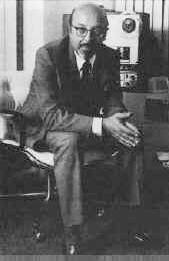
Atlantic was one of great independent labels that sprang up in the late Forties, challenging the primacy of the major labels of the time (RCA, Columbia and Decca) by discovering, developing and nurturing new tale
Ahmet Ertegun's Atlantic
Records

Atlantic was one of great independent labels that sprang up in
the late Forties, challenging the primacy of the major labels of
the time (RCA, Columbia and Decca) by discovering, developing and
nurturing new tale
|
|
|
|
|
Atlantic became the nation's premier rhythm & blues label in a few short years and would become one of the great soul labels in the Sixties.Atlantic set the standard for the "indies" in that they paid their performers fairly, produced top notch records, had talented session men and had knowledgeable staff that included producer Jerry Wexler, engineer Tom Dowd and arranger Jesse Stone. Atlantic's first stars were Ruth Brown, Joe Turner, the Clovers and the first Drifters. Atlantic's first releases were jazz oriented jump blues though the labels first big hit was "Drinkin' Wine Spo-Dee-O-Dee" by Stick McGhee. In the late Forties Atlantic went to New Orleans to look for talent and had some sessions with Professor Longhair, which convinced them to incorporate the New Orleans sound into their recordings. Atlantic's more sophisticated and jazz orientated session men were unable to recreate the New Orleans Sound, but in the process created the "Atlantic Sound," which supported all the label's singers with, boogie based, sax-led band arrangements that were internal part of the song.
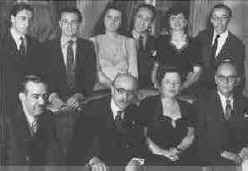
Ahmet Ertegun was born in Turkey. He and his family came to the United States when his father Munir was appointed Turkey's first ambassador to the United States. In 1936 it was decreed that every Turkish citizen was to choose a surname. Prior to that people had simply been know as "Son of James," "Son of Richard". Ahmet's father Munir choose the surname Ertegun which means "Living in a hopeful future." His mother Hayrunisa Rustem was very musical, terrific dancer and with a beautiful voice she played every instrument by ear. There was a lot of music in the Ertegun household with Hayrunsia buying the popular music of the day. Ahmet's older brother Nesuhi was introduced to many different artists and by age of five Ahmet had fallen in love with jazz. At night they would sneak records into their rooms and fall asleep listening to them. Eventually the bothers would build an over 15,000 collection of rhythm and blues and jazz records.
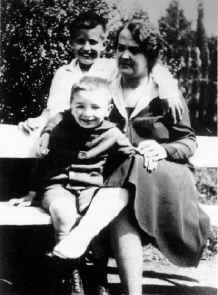
At the age of fourteen Ahmet's mother brought him a record-cutting machine. Taking a Cootie Williams instrumental "West End Blues" he wrote lyrics to it. With the instrumental playing on a record player Ahmet turned recording machine and sang the lyrics into the microphone as the record played.
Ahmet and Nesuhi liked to go looking for old records by the great bands. Two of the record shops they frequented were the Hot Record Shop and Commodore Music Store. The later was owned by Milt Gabler who would later become A&R head of Decca Records.
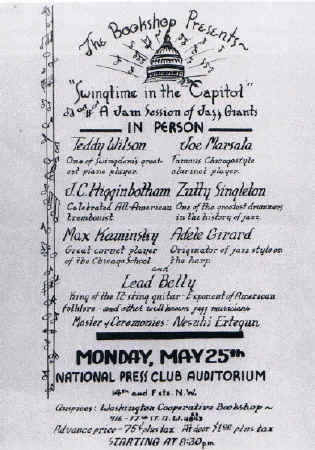
As the brothers became friends with Duke Ellington, Lena Horne and Jelly Roll Morton they decided to put on the first integrated concert in Washington D.C. Having trouble finding a venue where they could hold the event they held it at the Jewish Community Center, which was the only place that would allow a mixed audience and mixed band. Later they would be allowed to use the National Press Club's auditorium.
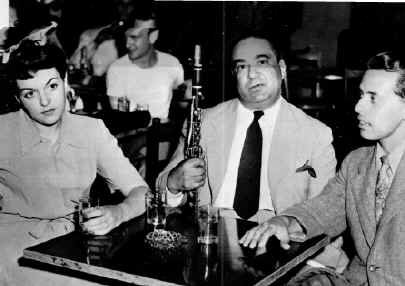
Marili Morden, Jimmie Noone and Nesuhi - Los Angeles 1943
Around 1943 Nesuhi met and married Marili Morden who owned a specialty record store in California called the Jazzman Record Shop. Nesuhi spent an increasing amount of time on the West Coast discovering and promoting the music they both loved.
In 1944 Munir Ertrgun died and was buried in Arlington National Cemetery. After the end of the war the body was taken back to Turkey for burial. Soon after the family returned to Turkey, Ahmet and Nesuhi, rather then returning to Turkey to finish their studies, elected to stay in the United States.Ahmet ostensibly to undertake post-graduate music studies at Georgetown.
Ahmet went out and rented a small apartment with his small allowance. Offered various jobs by family friends Ahmet turned them down. Instead he decided that he would get into the record business. This was to just be a temporary thing to help put him through college after which he would return to Turkey.
|
|
While going to graduate school Ahmet discovered Quality Radio Repair Shop which besides selling new and used radios and repairing them sold records for 10 cents or three for a quarter. The store was owned by a man named Max Silverman. Eventually Max would phase out the radio repair business and concentrated on the record end. The name of the shop was then changed to Waxie Maxie. Soon Silverman got out of the used end into the new record business. He also began a radio program where independent record owners came to get their records played. Ahmet became friends with him and it was here that he learned the record business, understanding what people were buying and why.
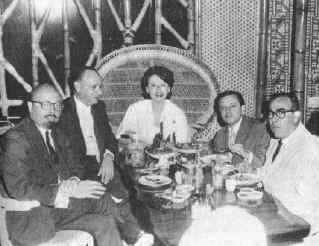
L to R: Ahmet Ertegun, Max Silverman,
Miriam Abrahamson, Nehusi Ertegun, Jerry Wexler circa 1953
In 1946 Ahmet became friends with Herb Abramson, a dental student and A&R man for National Records. Deciding to start a label together they talked Max Silverman and family dentist Vadhi Sabit into backing them. There was to be two labels Jubilee for gospel and Quality for jazz and R&B.
After recording a couple records that didn't sell and Silverman wanted out. Keeping the Jubilee label open, Abramson would sell it to Jerry Blaine to raise $2500 to start the new company. Unable to convince any of his father's friends to invest Ahmet turned to Dr. Vahdi Sabit the family dentist. Sabit then put up $10000 by mortgaging his house.
The name Atlantic wasn't the first choice for the company. It seems every name they came up with had already been taken. Hearing of a label called Pacific Jazz they decided to call themselves Atlantic.
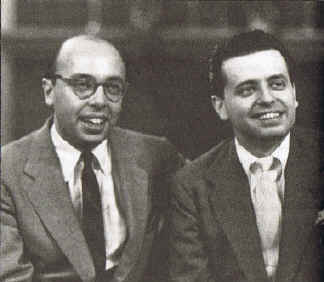
Atlantic Records was founded in September 1947 in New York City and incorporated in October 1947 with Abramson as president, Etregun vice-president in charge A&R, production and promotion. Abramson's then wife Miriam ran Atlantic's publishing company and handled most of the office work.
|
|
Atlantic was incorporated in October 1947 and was run by Abramson (president) and Ertegun (vice-president in charge of A&R, production and promotion). Abraham's wife Miriam rant the label's publishing department, Progressive Music and did most of the office work until 1948 when Francine Wakschal was hired as a bookkeeper. She would stay with Atlantic for the next forty-nine years.
Atlantic's first office was in the the Ritz Hotel on Fifty-Six between Sixth and Broadway, but when that proved to expensive it was moved to the Jefferson Hotel where the rent was $65.00 a month. Sleeping in the bedroom, the living room was used as a office. In order to help with the rent Ahmet rented a bed to his cousin Sadi Koylan a poet. With an upcoming recording strike declared by Caesar Petrillo to commence January 1, 1948 they began recording as much material as possible. The first sides were recorded November 21, 1947 by the Harlemaires with "The Rose of the Rio Grande." By the end of December a total of sixty-five songs had been recorded.
Among Atlantic's first records were recorded in January,1948 was Joe Morris's "The Spider" and Tiny Grimes's "That Old Black Magic."
In 1948 Abramson and Ertegun on the recommendation of Willis Conover went to the Crystal Caverns Club in D.C. where they heard a twenty year old Ruth Brown sing. They promptly invited her to New York to record, but she never made it. On the way she was involved in auto accident and ended up in Chester Hospital in Pennsylvania, unable to walk for several months. Though not yet signed Atlantic paid her bills for nine months.
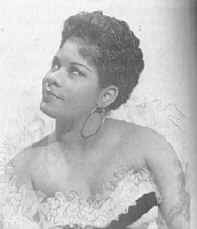
Ruth Brown mid-50s
While Ertegun was visiting her in the hospital, on her twenty-first birthday, Brown was signed to Atlantic. Her first record "So Long" reached #8 on the R&B chart. Brown went on to record more than eighty songs for Atlantic, becoming the most prolific and best selling artist of that time. It was said of Atlantic "Was The House That Ruth Built."
Ruth Brown was inducted into the Rock and Roll Hall of Fame in 1993.

Stick McGhee
Photo courtesy Michael Ochs Archive
In 1949, Ahmet and Stone began travelling through the South trying to understand why their well-made, up-to-date records weren't selling. Watching the crowds night after night in the dance clubs they saw the people, especially the young ones, dancing in a new way, that they couldn't dance to the classy, urbane Atlantic beat. So Stone took an instrumental version of "Sorghum Switch" re-named it "Coleslaw," added a special bassline; he put country blues into city sound and it clicked. In April Atlantic had its first major hit with Stick McGhee's "Drinkin' Wine Spo-Dee-O-Dee.
Joe Morris one of Atlantic's earliest artists had a hit in October 1950 with "Anytime, Anyplace, Anywhere," the first Atlantic 45 rpm.
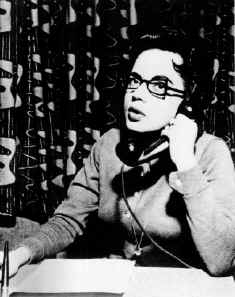
Miriam Abramson Beinstock
In 1951, The Clovers "Don't You Know I Love You" became Atlantic's first R&B number one followed by Ruth Brown's "Teardrops From My Eyes" their first million seller.

In 1952, Ray Charles was signed. With a pounding piano and gospel voice, Charles gave Atlantic more hits which included "I Got a Woman," "What I Say," and "Hallelujah, I Love Her So."
In January 1953, Herb Abramson was drafted by the army and sent to Germany, where he served as a dentist in the Army Dental Corps. While in the service he retained his position as president and continued to receive his full pay. In June of that year, Billboard reporter Jerry Wexler was brought to Atlantic replace Abramson for two years. He was sold a partnership, paying $2063.25 for a 13% share. Later he and Ahmet would buyout Miriam Beinstock, Abramson's ex-wife and Dr. Sabit. Nesuhi Ertegun would join as a third partner.
Later in 1953, Ertegun upon hearing that Clyde McPhatter had been fired from Billy Ward and His Dominoes, was forming a new group the Drifters, signed him to Atlantic. Their "Money Honey" became the biggest R&B song of the year as well as being banned by various stations.
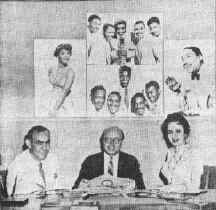
July 1954 - JerryWexler, Ahmet Ertegun and
Miriam Abramson
In 1954 Atlantic was besieged with covers and that summer seven songs including "Sh-Boom", "Honey Love" and "Such A Night" by the Drifters were covered by 18 different artists.
Recording engineer and producer Tom Dowd played a big part ion Atlantic's success. Initially working free lance, but within a few years he became Atlantic's full time staff producer. His recordings for both Atlantic and Stax greatly influenced music and he would have more hits than George Martin and Phil Spector combined.
They began the Cat label in 1954 and Atlas Records in July 1955. Atlas became Atco because there was already another Atlas label. Leiber and Stoller's Spark Records and it's catalog was acquired later in 1955.
In 1955, Abramson was released by the army returned to Atlantic with his German girlfriend that would lead to a divorce with Miriam. However the balance of power had shifted away to Wexler and eroded further when Nesuhi, Almet's older brother joined the company and made a partner. Nesuhi headed up the Jazz department as well as being in charge of LP production.
In 1955 Abramson was put in charge of Atlantic's Atco subsidiary that had much success with Bobby Darin. Darin started out slow and Abramson planned to drop him However Ertegun offerred him another just resulting "Splish Splash" which sold 100,000 records in the first and went on to sell a million. "Queen of the Hop" Top 10 R&B and Pop. "Dream Lover" reached Number two and went on to be a multi-million seller.1959's "Mack the Knife" went to Number One, sold two million copies and won the 1960 Grammy for Record of the year. "Beyond the Sea" became Darin's fourth consecutive Top Ten hit. An unhappy Abramson would decided to leave and in December, 1958, a $300,000 buyout was given with his stock divided between Nesuhi and Miriam, who had remarried publisher Fred Beinstock, as a substitute for alimony for her and child support for their son.
With Abramson leaving Ahmet became president, Wexler executive vice-president and general manager, Miriam Beinstock vice-president and president of Progressive Music Atlantic's publishing branch.
In 1955 Atlantic offered Colonel Tom Parker $25,000 for Elvis Presley's contract, but lost out on it to RCA $40,000 bid.
Nesuhi met Leiber and Stoller and introduced them to his brother Ahmet and other Atlantic executives. They signed a deal with Atlantic Records that called for them to provide material and produce records. Atlantic would record, release and promote their records for which they would be paid a royalty. They were to be paid a two cent royalty per record sold. The songs would be co-published with Tiger Music with Stoller and Leiber getting writer royalties. Thus they would become the first writer-producers to get a free lance arrangement with a label.
After a dispute over unpaid royalties would precipitate the end of Atlantic's Leiber and Stoller's relationship. In the past the payment of producer royalties was on a "handshake agreement," but in 1962 their accountant called for a written contract and audit which turned up a $18,000 short fall. When Stoller demanded payment Ertegun told him he would pay it, but that would be the end of the Atlantic-Leiber and Stoller relationship. Stoller then had second thought and dropped his demand. They would soon leave to start their own label, Redbird.
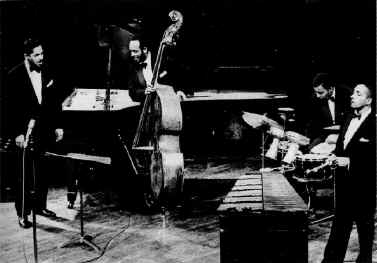
The Modern Jazz Quartet, from left: John
Lewis, Percy Heath, Connie Kay and Milt Jackson
Nesuhi Ertegun joined Atlantic in 1956, initially developed Atlantic's album department and built up the label's extensive catalog of jazz long-players. Netsuhi produced the following jazz artists at Atlantic: John Coltrane, Charles Mingus, Ornette Coleman, the Modern Jazz Quartet. Later he would become became involved with the label's rhythm & blues and rock and roll roster as well, producing several hit records for Ray Charles, the Drifters, Bobby Darin and Roberta Flack.
In 1959 Bobby Darin and Ray Charles left Atlantic, Darin signing with Capital records and Charles with ABC Records.left Atlantic and signed with Capitol Records.
In 1959 on the recommendation of Lester Sill, Phil Spector moved to work with Leiber and Stoller. Spector had learned production at Trey Records . a label in Californis owned by Lester Still and Lee Hazelwood and distributed by Atlantic.Leiber and Stoller got him work as a session musician and later production work. He was assigned to produce : Corrine, Corrina" by Ray Peterson and "Pretty Little Angel Eyes" by Curtis Lee both which became hits. He was then hired as a staff producer.
Spector was liked by Ahmet, tolerated by Leiber and Stoller and disked by Wexler. When Spector critized Bobby Darin's songwriting, Darin had him thrown out of his house.
Atlantic tolerated Spector, but Spectors productivity soon began to ebb. He produced "Twist and Shout' for the Top Notes which bombed. Bert Burns re-recorded it with the Isley Brothers and it became a hit. During his short time at Atlantic, Spector produced music for LaVern Baker, Ruth Brown and Billy Storm. In 1961, Spector returned to Los Angeles and started Philles Records with Lester Sill.
In 1960, Atlantic began a relationship with Memphis's Stax/Volt Records. Atlantic's Memphis distributor Buster Williams contacted Wexler and told him of pressing large numbers of "Cause I Love You" on Satelitte Records. Wexler contacted Jim Stewart who along with his sister Estelle owned the label. A deal was made for Atlantic to obtain obtain national distribution rights to "Cause I Love You" for a $1000 and small royalty for each single sold. Stax was paid $5000 for a five year option on all duets by Carla and Rufus Thomas-or so Stax believed. The true facts would come out later in 1961. "Gee Whiz (Look At His Eyes)," Carla Thomas's solo debuted. At that time it was discovered the contract gave ownership rights to not only that record but all others too. The deal began a successful eight year relationship in which Stax gain access to Atlantic's promotion and distribution and Stax providing production and masters.
In 1961, Wexler signed Solomon Burke. The first record Wexler produced on Burke "Just Out of Reach" became a big hit in September, 1961. Burke was consistent big seller throughout the mid-60s.
In 1964 Leiber and Stoller approached Jerry Wexler and propsed a merger with Atlantic. Wexler turned the meeting down, but Ertegun claimed that the real purpose of the meeting was to buy him out.. In September 1964, Ertegun brothers and Wexler were in the process of buying Sabit and Bienstock out and it was suggested that Leiber and Stoller buy Sabit's shares. Ertegun believed that real end was to buy him out and that Wexler was in on the plan. Wexler told Etregun if he refused the deal would be done without him, but the Etregun's held the majority of the stock, so the deal wasn't done. Thus began Ertegun's lifelong grudges against Leiber and Stoller and his relationship with Wexler was damaged.
In 1966, Atlantic signed a licensing deal with Polydor whose acts included Cream, whose debut album was released on Atco. Also in 1966,, after her contract with Columbia expired Aretha Franklin was signed. Wexler took her to the Fame Studio in Muscle Shoals, Alabama where he personally produced her. The result was seven straight singles that charted Top Ten Pop and Soul. They were "I Never Loved a Man (L:ike I Loved You)," "Respect," "Baby, I Love You," "(You Make Me Feel Like) A Natural Woman," "Chain of Fools," "Since You've Been Gone" and "Think".
Seeing what had happened and was happening to the independents, Wexler began pushing for Atlantic to be sold to larger company. Ahmet didn't want to sell, but was out voted when Nesuhi sided with Wexler. In October, 1967 Atlantic was sold for $17.5 million to Warner Brothers-Seven Arts. Atlantic was allowed to continued to operated separately from the group's other labels:Warner Brothers and Reprise Records
With the sale Wexler became increasingly unhappy with Atlantic and the direction it was heading. As an independent Wexler had complete control, but after the sale the company became to big for him to control. He increasingly became alienated by the white acts that were more and more the basis of Atlantic's profits and success. It distressed him even more that black acts that he liked Ben E. King, Solomon Burke et al were leaving Atlantic. Wexler's solution was to leave New York for Miami. Following Wexler's leaving. Ertegun took over Atlantic's business affairs and quickly became a major force in expanding Warner music group.
The sale of Atlantic activated a clause in the distribution agreement with Stax calling for renegotiations.of the distribution agreement. It was at this time Stax became aware that the past deal had given Atlantic ownership to Stax records that Atlantic had distributed. Warner refused to give up ownership of the Stax masters, so the distribution agreement ended in May 1968.
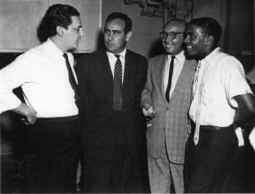
Herb Abramson, Jerry
Wexler, Ahmet Ertegun and Clyde McPhatter
In the late 60s, Ertegun came to the view the "white rock" was the natural progression from rhythm and blues and Atlantic began moving in the direction. First with Buffalo Springfield than to Crosby, Stills and Nash, sometimes with Neil Young. Other would include Blind Faith, bee gees, Led Zeppelin and the Rolling Stones.
In the '60s, Wexler became the primary producer who linked Aretha Franklin and Wilson Pickett with house bands in Memphis and Muscle Shoals, Ala., to help bring Southern soul to the rest of America. In the '70s, he continued to produce rock acts, such as Dr. John and Dire Straits.
In 1968 Atlantic established a new subsidiary Cotillion Records as a label for blues and Deep Southern soul.
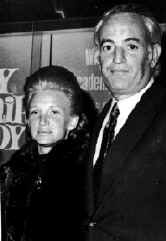
President of Kinney National Company Steve
Ross with his wife
In 1969, Warner Brothers-Seven Arts was sold to the Kinney National Company and in the early 70s was renamed Warner Communications. After buying Electra and its sister Nonesuch records in 1970, Warner combined all its labels under Warner Music Group
In January,1970, Ertegun was successful in his battle against Warner Brothers Records President Mike Maitland to keep Atlantoc autonomous and as a resule Maitland was fired by Kinney president Steve Ross. On Ertegun's recommendation Mo Ostin was made president of Warner Brothers and Atlantic was able to remain independent of Warner's and continue to do their own marketing,
In 1969 Atlantic signed Crosby, Stills and Nash. Their debut self-titled album released in May, 1969 was big hit reaching #6 on the Billboard album chart and producing two Top 40 singles, becoming a multi-platinum seller and eventually earning a place on Rolling Stone list of The 500 Greatest Albums Of All-Time.
Much of Atlantic's success as a rock label in the late 70s was due to A&R manager.John Kaloder. Kaloder a former photographer, record store manager and music critic joined Atlantic's promotion department in 1974. In 1975 he moved to the A&R department and eventually rose to Atlantic's first West Coast director of A&R in 1976. Over the next four years he was instrumental in signing major acts such as Foreigner, AC/DC, Petter Gabriel and Phil Collins.
In 1975 Wexler left the company and was replaced by Jerry Greenberg who originally had been hired and mentored by Wexler in daily running of the business. In seven years, Greenberg had gone from personal assistant to president of Atlantic. From Ertegun he learned who to handle musicians.
In May, 1998 a 40th anniversary concert was broadcast on HBO. The concert was almost thirteen hours long featuring songs by a large number of Atlantic's artists and included reunions of Led Zepplin and Crosby, Stills and Nash.
At the tenth annual Rock and Roll Hall of Fame
Induction Dinner in 1995, it was announced that the museum's main
exhibition hall would be named after Ertegun.
Jerry Wexler was inducted into the Rock and
Roll Hall of Fame in 1987
Amhet Ertegun was inducted into the Rock and
Roll Hall of Fame in 1987
Nesuhi Ertegun was inducted into the Rock and
Roll Hall of Fame 1991
Ruth Brown was inducted into the Rock and
Roll Hall of Fame in 1993
Jesse Stone was inducted into the Rock and
Roll Hall of Fame in 2010
Tom Dowd was inducted into the Rock and Roll
Hall of Fame in 2012
Atlantic Records at VinylReviews.com
Owner.com
Reviews and Product Details